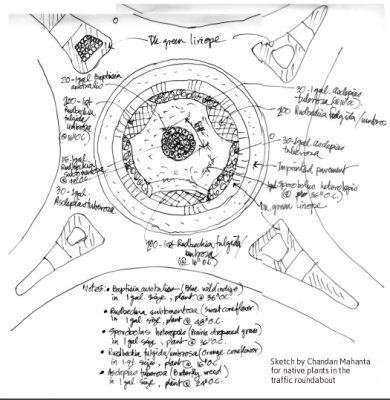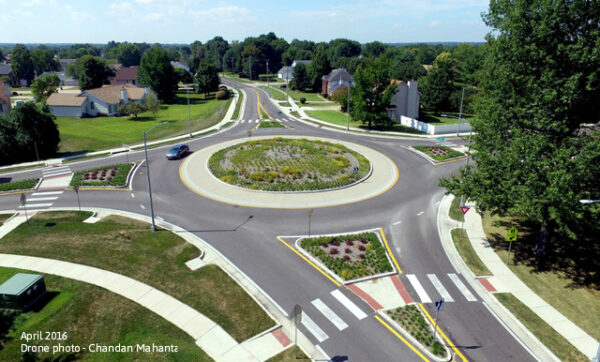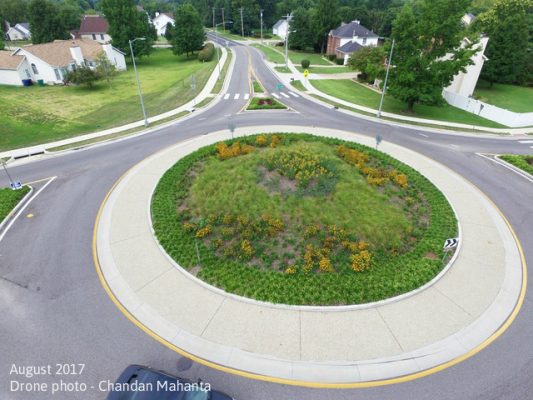By Chan Mahanta
- Member, Wild Ones – St. Louis Chapter
- Resident of the Old Jamestown area of North St. Louis County of which the roundabout project is a part
- Member of the St. Louis County Transportation Commission
- Past president of Old Jamestown Association
Continued from Part I: Native Plants in the Old Halls Ferry Road and Vaile Traffic Roundabout, North St. Louis County
At the time the project had been awarded and I was not pressing the issue any further, I was also the President of Old Jamestown Association. In that role, I met with our Councilman Mike O’Mara, from time to time, to discuss matters of interest. In such a meeting, shortly after my failure to get the native plants program for the traffic circle going, I informed him of my activities at the County Transportation Commission and mentioned to him about my failed effort. The Councilman was very supportive of the initiative.
In the meantime, there was a turnover of the County Administration with a new Director of Transportation. Our Councilman spoke to the new Director to see if he could do anything to revive my effort of incorporating native plants in the traffic circle. There was good news. The Transportation Department decided to incorporate my sketch of native planting design into the work. And on my part, I volunteered to look after the plants in the project personally, until they became established.
The work was completed in the fall of 2015. In the spring of 2016, I found that there was a massive growth of weeds of various kinds. I pulled a ton of them and had to return three times to keep them at bay. The physical work was a whole lot more than I anticipated.
I posted drone pictures of the project that I shot, to the Missouri Native Plants page in Facebook and mentioned the maintenance work required. There was a great deal of support and encouragement from Facebook members and several volunteers offered to help. Since it was late summer by then and things settled down, I promised to get back to them when I needed help again in the spring of 2017.
This spring, some of the weeds reappeared. I was travelling abroad and not here physically to take care of things in a timely manner. The neighboring sub-division president called the Transportation Department, inquiring why there was no maintenance, that the plantings looked bad (There were dead plants from the fall.), and complained that they did not want the traffic circle in the first place, and so on and so forth.
I got called, and the Transportation Department Project Engineer and I met with the sub-division president and members. I explained that it would take about three years for the plants to take hold and look full, information that did not go well with the neighbors.
A particular neighbor was very vocal about how ugly everything looked and demanded tearing everything down and redoing. The project engineer explained that they did not have a budget for maintenance work in these projects and depended on volunteers, like myself. I invited them to join me in the upkeep, but that was rejected outright. There was also this feeling of neglect of our area by the County, which had certain merit, and the neighbors did not fail to air that.
All combined resulted in the Transportation Department hiring a landscaping contractor to do some routine maintenance now. That has taken a big physical burden off my back. I noticed however that the maintenance workers, diligent as they are, are not exactly familiar with what are native plants and what are weeds. So I continue to make my visits to augment the work of the maintenance outfit.
Things are looking up. I got a very nice note from the county Maintenance Engineer and the neighborhood organization president, who agrees things are looking better.
I am encouraged by the turn of events. It takes some doing, but those of us who are attempting to promote and popularize the use of native plants in landscaping can make a positive impact with successful efforts in demonstrating its efficacy.





Budgets are tight all over. In Joplin, I have found if you volunteer to make a planting (eg Monarch Waystation or pollinator planting), YOU OWN IT and will need to plan for maintenance in perpetuity. This works OK if you are part of a group, but can be overwhelming for an individual. Keeping this in mind is important in not overtaxing your ability to have your “gift” of a native planting keep in giving!
I agree. I too am concerned about who will take it up, when I cannot any more!
Chan, I honor you for your persistence. Well done!
Thanks Ed!
Thanking you, Chan, for your efforts – and passing on info from your experience about owning a planting -I am unable to commit any time right now to help out but maybe in the future I will be able to help-sharing with you my reason-I am continuing to deal with overgrowth of weeds esp. honey suckle at my backyard border with my neighbors thus weeding is a continuous part of our schedule-wishing you a blessed Christmas season – take care –
Have a great Christmas yourself too Teresa. I think we are going to be OK on the roundabout maintenance issues. Thanks.